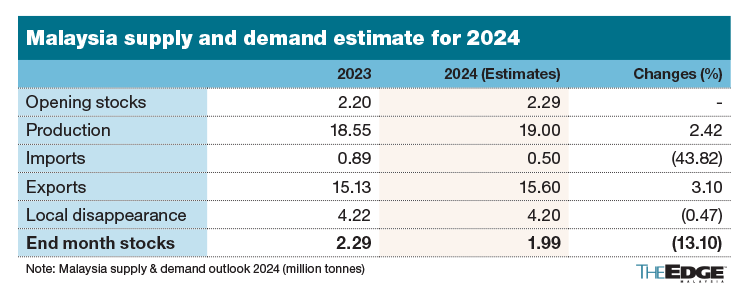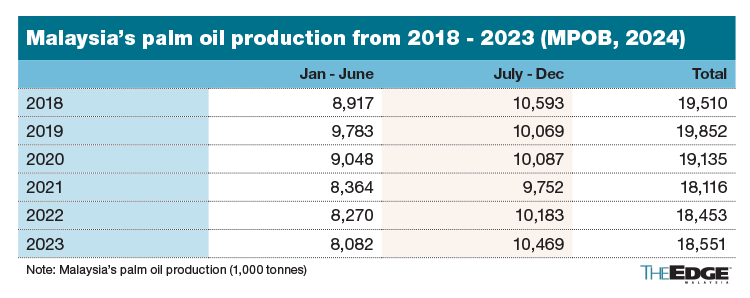
KUALA LUMPUR (July 9): Crude palm oil (CPO) prices are expected to trade within the range of RM3,800 per tonne to RM4,200 per tonne in the second half of 2024 (2H2024), Malaysian Palm Oil Council (MPOC) chief executive officer Belvinder Kaur Sron said, with production conditions remaining the main factor influencing prices.
She noted that Malaysian palm oil production from January to June 2023 was the lowest since 2018, affected by El Nino. In contrast, palm oil production from July to December 2023 reached its highest level since 2018.
“As a result, palm oil production growth momentum in the second half of 2024 is expected to slow down due to high base effect, which is supportive for palm oil prices,” she said in an email response to questions from The Edge.
The combined palm oil production of Indonesia and Malaysia, the world’s top two producers of palm oil, in the first four months of 2024 showed a supply deficit of 200,000 tonnes. From January to April 2024, Malaysian palm oil production increased by 440,000 tonnes, while Indonesia’s production decreased by 640,000 tonnes.
“The slowing production growth in both Malaysia and Indonesia, coupled with stable demand from India and China, will keep palm oil prices robust. If Indonesia increases its biodiesel blending rate to B40 in 2025, global palm oil supply will tighten further,” Belvinder said.
In terms of demand, she is of the view that palm oil exports from Malaysia are expected to remain strong, driven by India’s imports in preparation for Deepavali in October.
“Additionally, as China enters summer in June, palm oil consumption is expected to rise, leading to increased imports. According to MPOC market intelligence, palm oil inventories in both China and India as of June are at their lowest levels since August 2022,” she added.
Meanwhile, MPOC is estimating that Malaysia’s palm oil inventory will remain under pressure for the rest of this year, with an estimated level of around two million tonnes by December.
In 2024, Malaysia’s palm oil production is projected to increase by 2.4%, reaching 19 million tonnes, while exports are expected to rise by 3.1%, reaching 15.6 million tonnes. Domestic consumption in the country is anticipated to remain stable at 4.2 million tonnes, the same as in 2023.
Belvinder said the top two challenges in the palm oil industry are the increasing dependence on foreign labour and the slow pace of mechanisation.
“This situation (dependence on foreign labour) continues to hinder the overall productivity and production growth of the sector. According to the Malaysian Palm Oil Association (MPOA) data, 80% of workers in oil palm estates are foreign labour,” she said.
Another significant challenge is the lack of replanting old and unproductive trees, which has sharply reduced yields from their peaks, she noted. MPOA data indicates that approximately 31% of oil palm trees in Malaysia are currently over 20 years old and unproductive.
“Therefore, addressing these challenges is the only way to increase palm oil production in Malaysia, as the government is committed to no new land clearing for oil palm plantations," Belvinder said.
Analysts are maintaining their “neutral” call on the plantation sector, given that Malaysia’s CPO production is poised to see stronger growth in 2H2024, as oil palm trees enter a high production cycle amid favourable weather.
After a roller coaster ride in 1H2024, with CPO prices trading in the range of RM3,600 per tonne to RM4,600 per tonne, analysts are expecting prices to remain volatile, given the market and weather uncertainties that could have an impact on crop production and prices.


